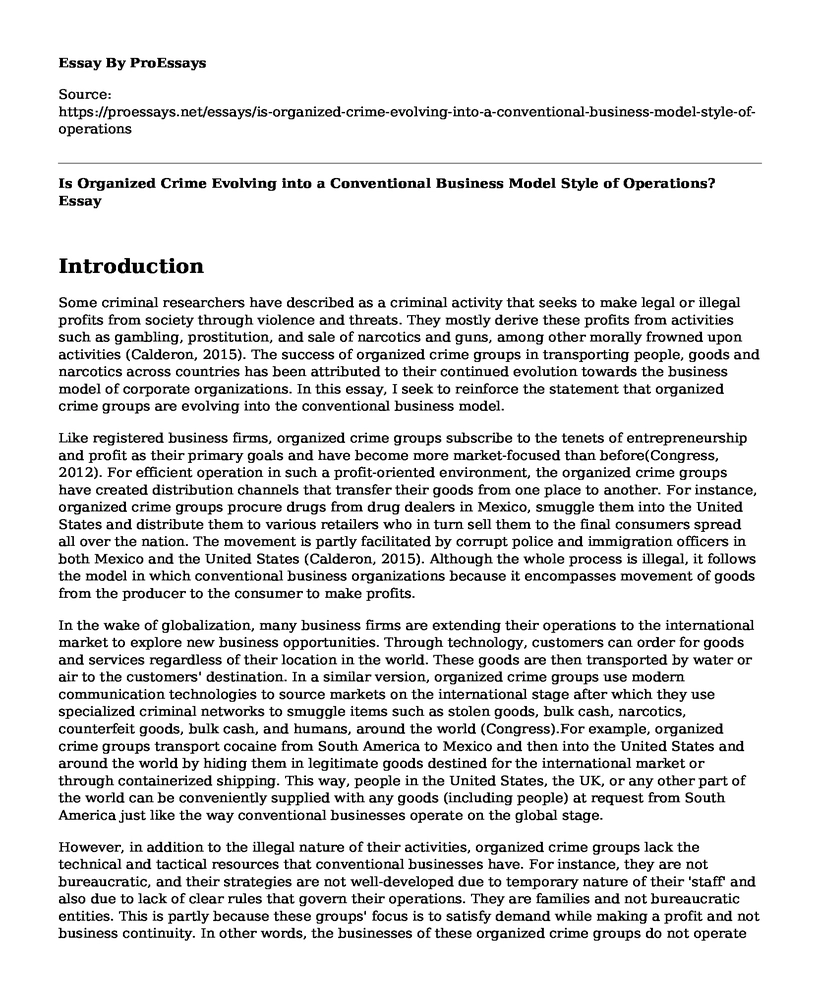Introduction
Some criminal researchers have described as a criminal activity that seeks to make legal or illegal profits from society through violence and threats. They mostly derive these profits from activities such as gambling, prostitution, and sale of narcotics and guns, among other morally frowned upon activities (Calderon, 2015). The success of organized crime groups in transporting people, goods and narcotics across countries has been attributed to their continued evolution towards the business model of corporate organizations. In this essay, I seek to reinforce the statement that organized crime groups are evolving into the conventional business model.
Like registered business firms, organized crime groups subscribe to the tenets of entrepreneurship and profit as their primary goals and have become more market-focused than before(Congress, 2012). For efficient operation in such a profit-oriented environment, the organized crime groups have created distribution channels that transfer their goods from one place to another. For instance, organized crime groups procure drugs from drug dealers in Mexico, smuggle them into the United States and distribute them to various retailers who in turn sell them to the final consumers spread all over the nation. The movement is partly facilitated by corrupt police and immigration officers in both Mexico and the United States (Calderon, 2015). Although the whole process is illegal, it follows the model in which conventional business organizations because it encompasses movement of goods from the producer to the consumer to make profits.
In the wake of globalization, many business firms are extending their operations to the international market to explore new business opportunities. Through technology, customers can order for goods and services regardless of their location in the world. These goods are then transported by water or air to the customers' destination. In a similar version, organized crime groups use modern communication technologies to source markets on the international stage after which they use specialized criminal networks to smuggle items such as stolen goods, bulk cash, narcotics, counterfeit goods, bulk cash, and humans, around the world (Congress).For example, organized crime groups transport cocaine from South America to Mexico and then into the United States and around the world by hiding them in legitimate goods destined for the international market or through containerized shipping. This way, people in the United States, the UK, or any other part of the world can be conveniently supplied with any goods (including people) at request from South America just like the way conventional businesses operate on the global stage.
However, in addition to the illegal nature of their activities, organized crime groups lack the technical and tactical resources that conventional businesses have. For instance, they are not bureaucratic, and their strategies are not well-developed due to temporary nature of their 'staff' and also due to lack of clear rules that govern their operations. They are families and not bureaucratic entities. This is partly because these groups' focus is to satisfy demand while making a profit and not business continuity. In other words, the businesses of these organized crime groups do not operate as a going concern-they live on the edge.
Conclusion
In conclusion, organized crime groups have created distribution channels that supply goods in the local and the international market. Technology and corruption mostly facilitate this distribution. However, their businesses do not operate as a going concern, and lack clears rules of operations, two essential features that drive the operation of conventional businesses. Given the above features, they cannot be said to have evolved to a level where their operations fully follow the conventional business model, but indications are that they are headed in that direction. As technology evolves, organized crime groups can be expected to continue evolving towards a business model similar to that of conventional businesses.
References
Bjelopera, J. P., & Finklea, K. M. (2012). Organized crime: An evolving challenge for U.S. law Enforcement. Retrieved from Congressional Research Service website: https://fas.org/sgp/crs/misc/R41547.pdf
Calderon,, F. (2015). Drug trafficking and organized crime: Connected but different. Harvard International Review. Retrieved from http://hir.harvard.edu/article/?a=11786
Kregar, J., & Petricusic,, A. (2012). Crime as a business, business as a crime. Journal of Criminal Justice and Security, 4(1), 367-377.
Cite this page
Is Organized Crime Evolving into a Conventional Business Model Style of Operations?. (2022, Mar 31). Retrieved from https://proessays.net/essays/is-organized-crime-evolving-into-a-conventional-business-model-style-of-operations
If you are the original author of this essay and no longer wish to have it published on the ProEssays website, please click below to request its removal:
- Homeland Security: Preparedness, Prevention, and Deterrence
- Essay Sample on Cyber Terrorism
- Essay Example on "Three Strikes" Law: Criminal Justice and Public Policy
- Essay Sample on Gender-Based Crime Trends & Statistics
- Gun Control: Divisive Issue in US, Analysis of Article - Essay Sample
- Investigations: Careful, Critical and Requiring the Act (Smith et al., 2017) - Essay Sample
- Victim Services and Courts - Essay Sample







